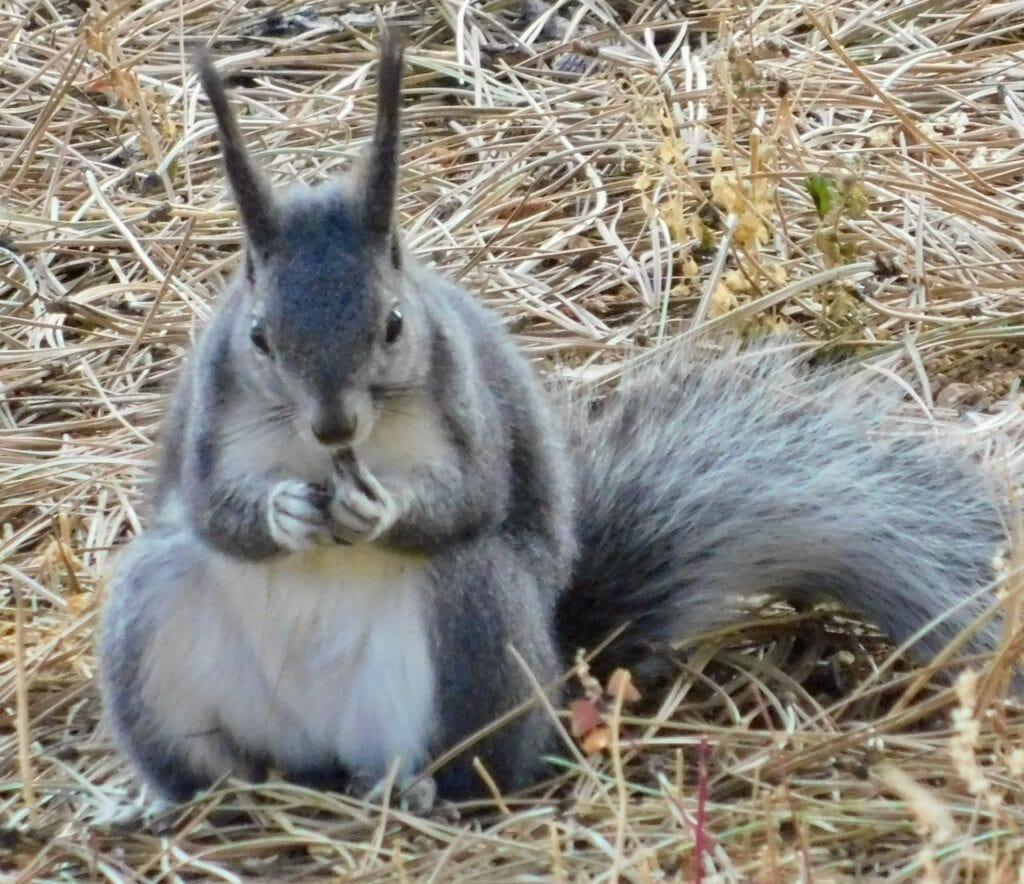A shadow just ran past the sliding screen door of my office.
Ran? Romped, hopped, paused, looked about, spun around, and shot up the nearest tree.
I stepped close to the door and watched him. He watched me in return while hanging on to the trunk of the nearest tree, about eye height to me. A low hum murmur, quietly squeaky, was his way of talking with me, staring right at me, claiming rights to this tree, to this forest, to this bird feeder. A little, gray Pine Squirrel shot down the tree trunk to chase the black squirrel away from his territory. He was chased around the tree for a time and a half and then dropped to the ground returning to check out the nibbles under the bird feeder once again.
An all-black squirrel with tasseled ears and a bottle-brush-style tail, black eyes melded right with his fur to create a silhouette look. A shadow romping around. As he neared the seed-saturated area under the bird feeder his buddy, dressed all in black also, pounced at him, causing a leap, a spin, and a parkour flip off the nearest tree trunk. Great fun chasing is.
Found mainly around the Ponderosa Pine forests of the American Southwest, the Tassel-eared Squirrel, also known as the Abert’s squirrel and related to the Kaibab squirrel of the Grand Canyon area is unique. Look on a world map and this squirrel’s territory is amazingly small. A thin stripe down the Front Range foothills of Colorado, a swoop around New Mexico and Northern Arizona, and some small bits in Northern Mexico. Here in Colorado, you won’t find Aberts in Denver, nor on the Western Slope. Just the foothills, just where the Ponderosa Pine trees grow. Sometimes I feel, just for me, just to make me smile. I fell hard for these little guys when we moved to the Colorado Foothills.
Aberts can be a gray and white variety also, affectionately called Gray-bert around here. They seem a bit bigger, with prominent paws, almost hands.
When not raiding the bird feeder, the Abert Squirrels nibble on the Ponderosa Pines. A tree of plenty, it provides calorie and nutrient-packed seeds in its woody cones and pollen pods. On many Ponderosas, you will see 'squirrel chew' on the branches as the tender inner bark of the young twigs have been nibbled on. A more difficult nutrition to acquire, but it will get a little guy through a long winter. Spring brings a treat, the little pollen cones emerge, gorged on in season until their black fur is stained shades of yellow, as are their scat. In summer, add in False Truffle Fungi that grow under the base of the Ponderosa Pines. This Hypogeous fungus, meaning, 'growing underground', is integral to the tree's life and health, it is fascinating stuff that will be the subject of future posts on their own. In late summer, this can amount to up to 80% of the Abert Squirrel's diet, which they spread about once again in their scat, aiding the trees in unseen networks.
So, a hidden food source, that is also a hidden nutrient conductor for the conifers they live in, and a little goof-ball that runs about spreading more of the fungus spores. One can’t live without the other and they blissfully are unaware of their reliance on each other, or perhaps they acutely are.
For all the selling features of this house and 5-acre property we moved to, being greeted by these little romping shadows on moving day (along with an army of ducks marching up to check us out) suddenly made a new house much more than we had hoped for. Everywhere we look, there is so much to take in here. Each animal, plant, tree, moss, flower, bird, rock, even the bugs (I do love dragonflies and big 'ol bumble bees), creates questions that lead to internet and book searches, which leads, of course, to more questions. The more I dig, the more I find the pieces that each entity relies on to be here. The obvious, delightful, sometimes intimidating even, that needs the small, the hidden, the less obvious to survive.
As I dig, I start to write, as I write, I figure others might want to know about the Aberts and all the other natural elements around us. Knowledge is also a hope that the reader would begin to look at their own location for all that surrounds their homes and neighborhoods. What's ahead to be found?








